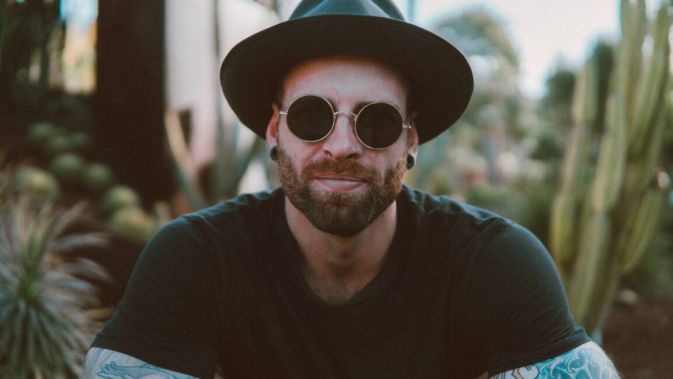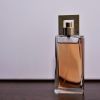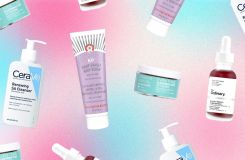
The distinction between a good mustache and a fantastic mustache typically comes down to one thing: style. A nice mustache can be plentiful on its own, but it lacks the purpose and direction of a styled mustache, much like someone can grow their hair out simply to show off the volume and plenitude. That’s why we all have different hairstyles: to express ourselves and our personalities. A mustache is no exception, and it all begins with the application of mustache wax.
Mustache wax keeps those tenacious, bristly ‘stache hairs in place. It’s usually enriched with soothing beeswax and oils to smooth and strengthen each strand. When you pair it with a well-kept mustache, you’ll be ready to take your whiskers from excellent to fantastic.
Continue reading to learn how to apply mustache wax, trim a mustache properly, and even create a dandy-like handlebar’stache. We enlisted the help of two of our favorite brand creators, whose mustache wax products are also two of our faves, for this tutorial. (They’re also recognized for their incredible capacity to grow A+ facial hair.)
Best Tips to Use Mustache Wax
Eric Bandholz is known for his perfect beard on the internet—a man who truly embodies his brand. And, because mustache wax comes with that hirsute terrain, we asked Bandholz for his suggestions on how to style the’stache with it.
step-by-step guide and instructions can be found here. We’re going with the most universal option: down and out with a middle part, because there are so many various ways to style a mustache. It’s a can’t-fail approach, according to Bandholz, and a perfect place to start for beginners. (See Beardbrand’s fantastic analysis for a thorough rundown of the best mustache styles.)
Grow It Out
To shape your mustache, it doesn’t have to be months old. Sure, some handlebar and dandier styles necessitate a significant amount of length, but with a few weeks or months of development, you can create a deliberate, moldable style. Hairs that are long enough to bend to the side rather than sticking straight out are required. (Anywhere from half a centimeter to a centimeter or more will reveal possible movement.) The amount of time required for this will vary from one mustachio to the next, depending on the rate of growth of each man.
Cleanse and Dry the ’Stache
You should start with a blank canvas. Plus, you should wash your face first thing in the morning anyway, so following the cleanse is the ideal time to apply mustache wax. (Just make sure the hairs are completely dry before applying the wax.)
Warm the Wax
Using a sliver of wax, apply a light layering to all of the hairs. Warm it between your two fingers (or your finger and thumb) before applying it. It’s just as simple to do this with two digits on the same hand as it is to do it with one digit on each hand—the choice is entirely yours.
Apply It
Bandholz advises that once you’ve warmed it up and divided it evenly between your two fingers, you’re ready to apply it to your’stache. “Alternatively, you can apply mustache wax straight from the tube if you’re using a mustache wax stick.” (See below for how Beardbrand’s Mustache Wax gets to your whiskers.)
Guide It Into Place
Bandholz says it’s as simple as combing the mustache in the desired direction—he recommends a center part for first-timers, with the hairs pointing down and out in either way. For this stage, you can use a mustache comb or your finger tips.
Blow Dry It (Optional)
You’re ready to go. No more flossing your teeth throughout the day with mustache hairs!
“Use a hair dryer on a warm setting to style into the right direction,” Bandholz explains of the optional last step. “After that, blast it with cool air to secure it.”
Show It Off
You’re ready to go. No more flossing your teeth throughout the day with mustache hairs!
Handlebar Mustache Tips
“For a handlebar mustache, you’re going to need a higher-hold product,” Bandholz says. “Our customers have had success using the styling balm to lock the handlebar curls into place”.
The first step is to apply the higher-hold product throughout the mustache, twizzling it into the ends, and combing it into place, just like you would with regular mustache wax. “However,” Bandholz advises, “you’ll want to wrap the ends of your’stache around a spherical object—your finger is usually the best option.” (Some males do it with a pen or pencil as well.)
After that, hold it in place for 15 seconds before letting it set. You can dry it on low heat and low electricity, then seal it for the day with a blast of cold air.
Handlebar Styling Hack: “Use an Elmer’s glue stick for extra-high grip around the curve of your handlebar,” advises Bandholz, whose legendary beard approves. It can also be used to define the curl as a round object.
Mustache Trimming Tips
“You want to focus on a couple locations when trimming the mustache,” Bandholz explains. “First, ensure that your lower nose hairs and mustache are somewhat separated. As a result, you’ll be trimming your mustache at the top.” Instead of letting everything grow out, this will assist shape and define the overall mustache. Only a few rows of hairs need to be trimmed down to create a noticeable impact. Rather than merely hoping for the best with your normal bare-guarded beard trimmer, use a trimming device with interchangeable detailed heads to meticulously snip away at each hair.
Trim along the lip line next. “The best practice,” Bandholz explains, “is when the hairs are slightly longer at the edge of the mouth and taper up toward the middle of the mouth.” With the ends of the’stache, this gives you more mobility and flourishing power—and it’s also the starting point for growing them out much longer, for a handlebar (if that’s ever your aim).
Finally, Bandholz advises against over-trimming the hair along the philtrum and in the middle of the lip (that divot between the nose and lip that is right down the center). Some guys will have a natural part in this area, while others will require the length of hairs in this area to style a natural part. Trimming it too much will make it difficult to build the part.
Mustache Wax FAQs
The following are some of the most frequently asked questions about mustache wax:
What does mustache wax do?
“Using mustache wax is largely about hold in the short term for folks who grow a lengthy mustache,” Keren adds. “It aids in the styling of the mustache and also serves to keep hair out of the mouth.” A decent mustache wax should provide nourishment and moisture to the hair and skin beneath it in the long run.”
Is mustache wax the same as beard balm?
“Most mustache waxes have a higher wax content (such as beeswax, carnauba, or other waxes), which is solid at room temperature and helps hold the hair in place,” Keren explains. “A balm, on the other hand, would be used primarily for hydration and nourishment, and would typically have a smaller proportion of wax, merely enough to keep it solid.” They’re typically used for the same thing, although a wax should be more effective in controlling short, stubborn hairs (which is most mustaches in their earlier stages).
What are some of the best types of ingredients to be found in a mustache wax?
“Aside from giving grip, beeswax is an excellent foundation wax since it is high in nutrients. “Carnauba or candelilla waxes might potentially give an excellent base for a vegan version,” Keren explains. “Butters like coconut butter or shea butter can provide a lot of moisture that lasts a long time. Essential oils like sandalwood, which is antibacterial and anti-inflammatory, and bergamot, which is anti-fungal and anti-inflammatory, are also beneficial. In general, no artificial additives should be present in mustache wax, beard balm, or even beard oil, so look for ‘fragrance’ as an ingredient or different preservatives.” However, many essential oils may give a natural aroma, which is OK.
Was this helpful?
Kingerlon collects & utilizes cookies from third-parties & affiliate networks to improve user experience. If you buy a product or service after clicking on one of our links, we may get a commission.








